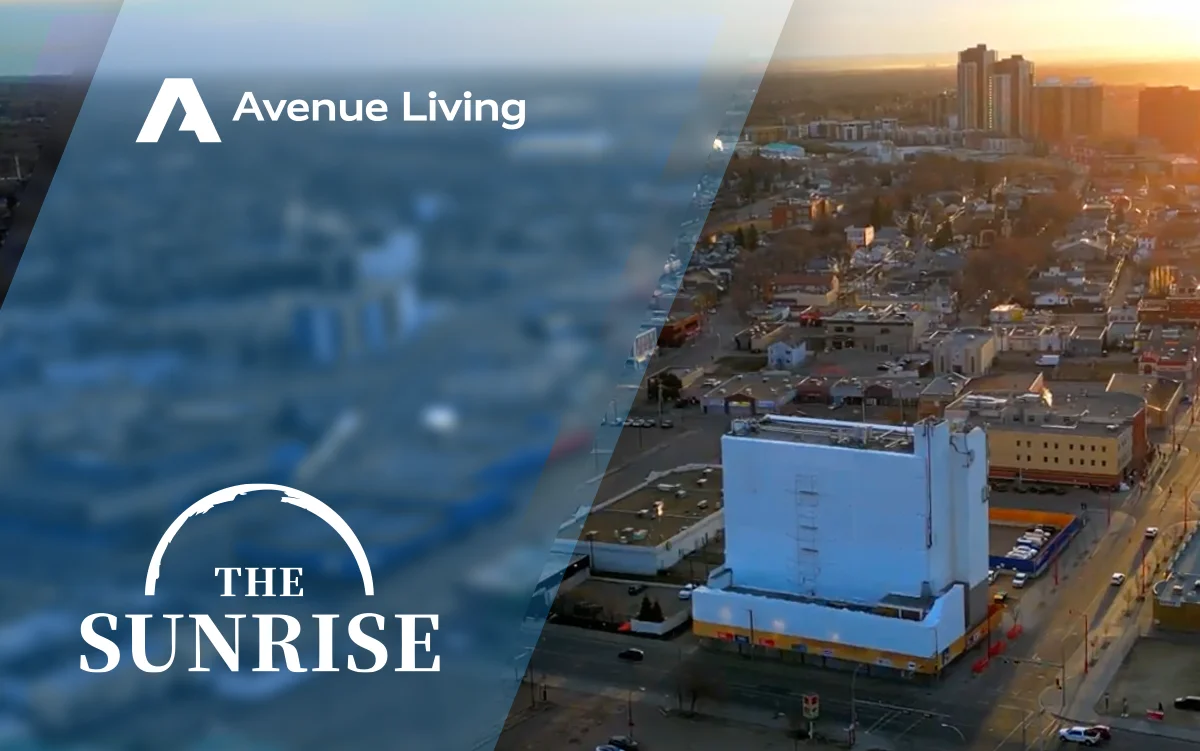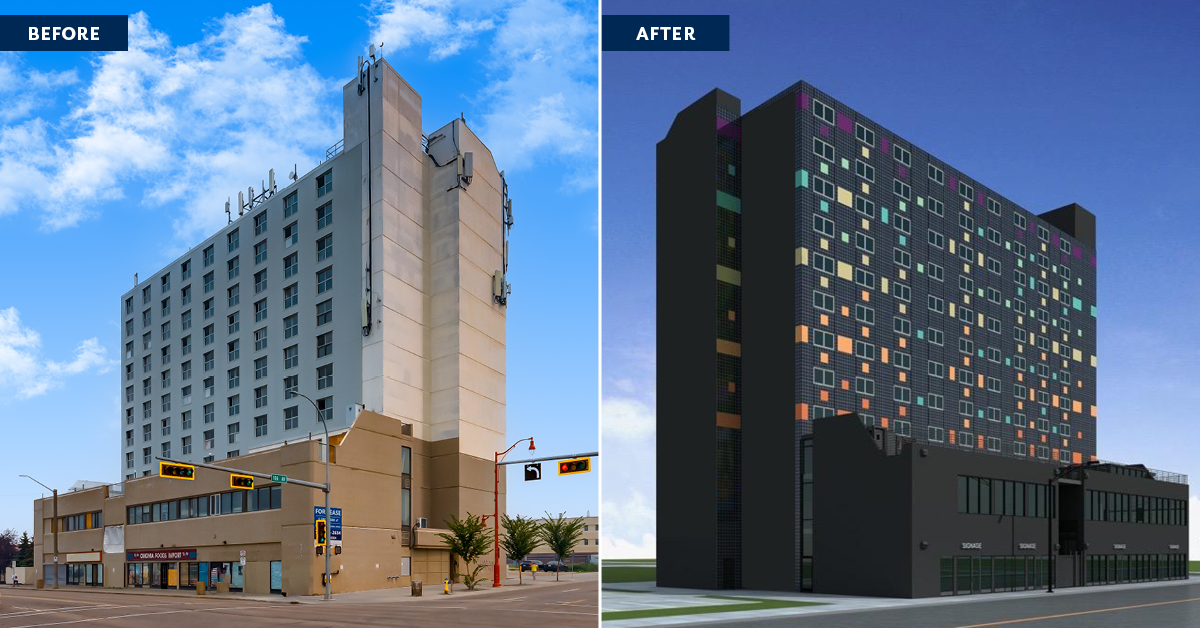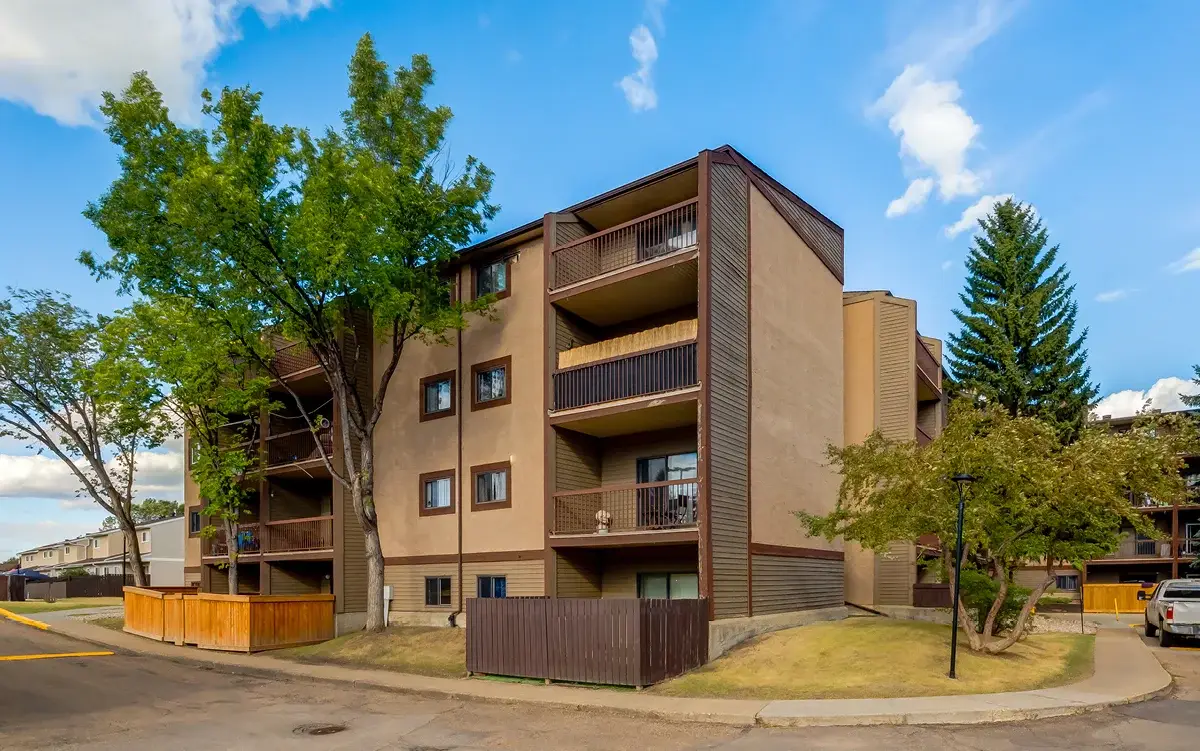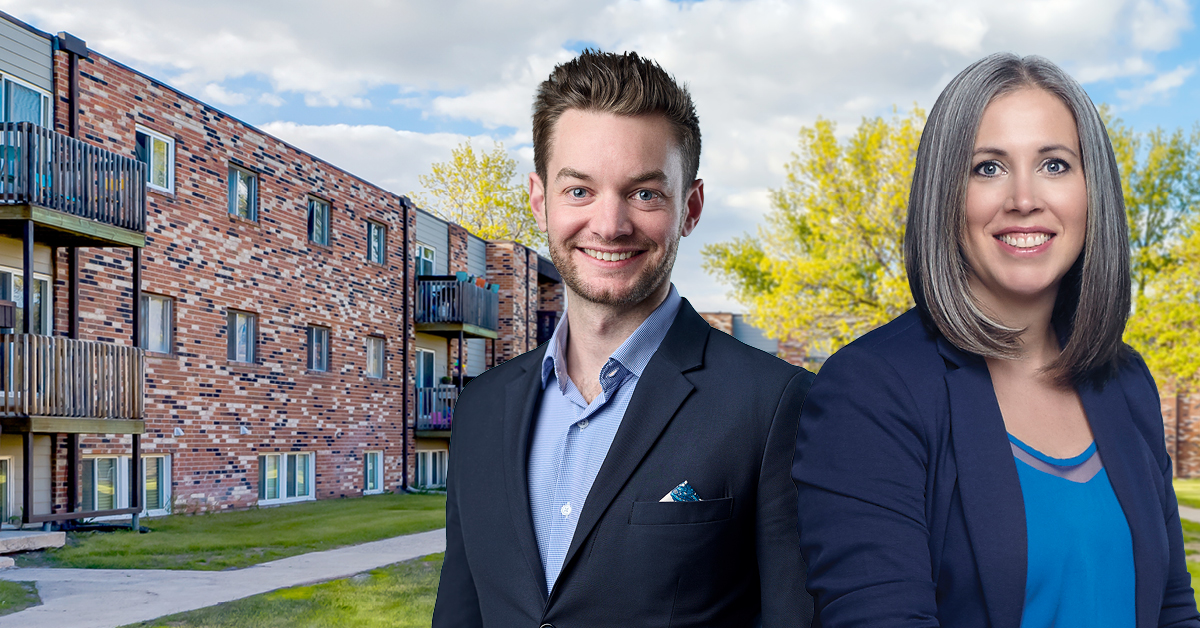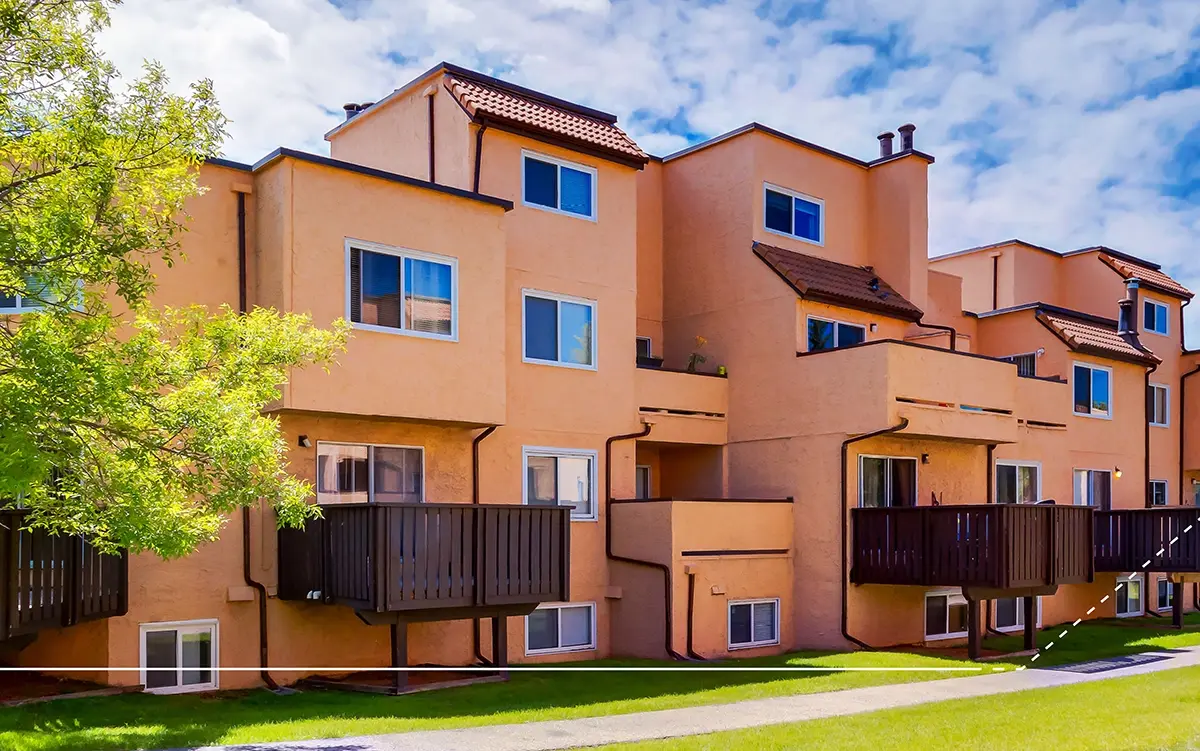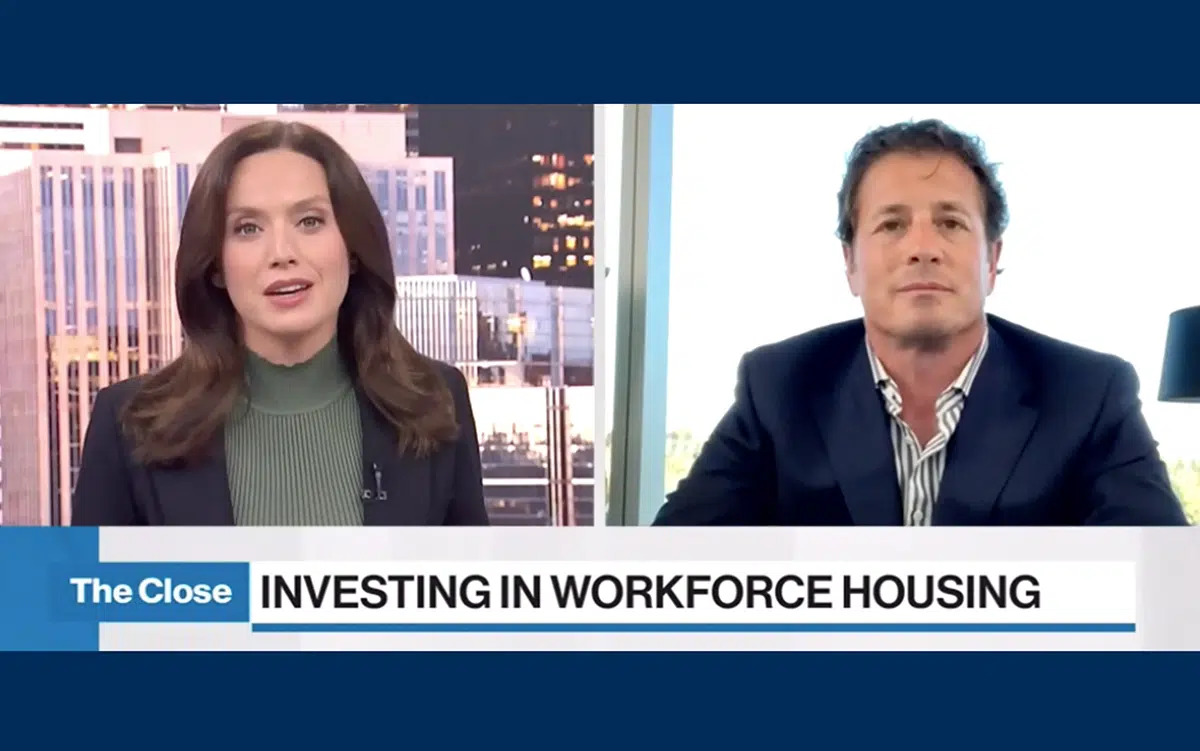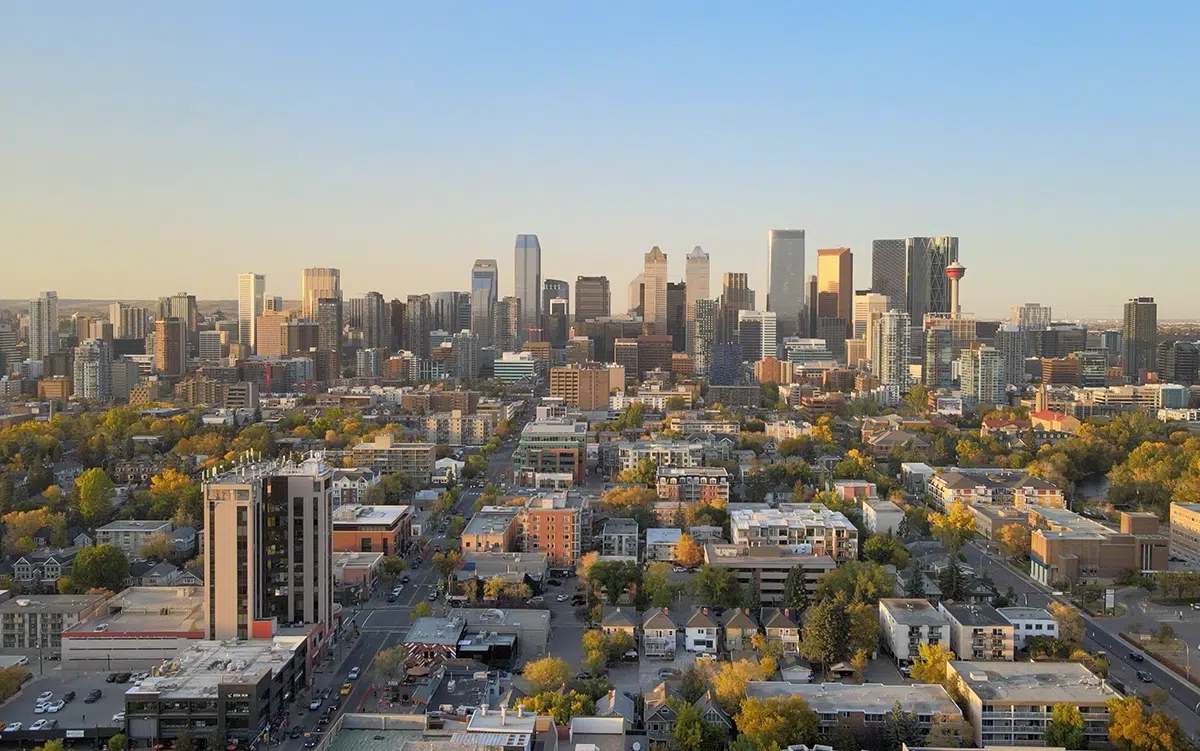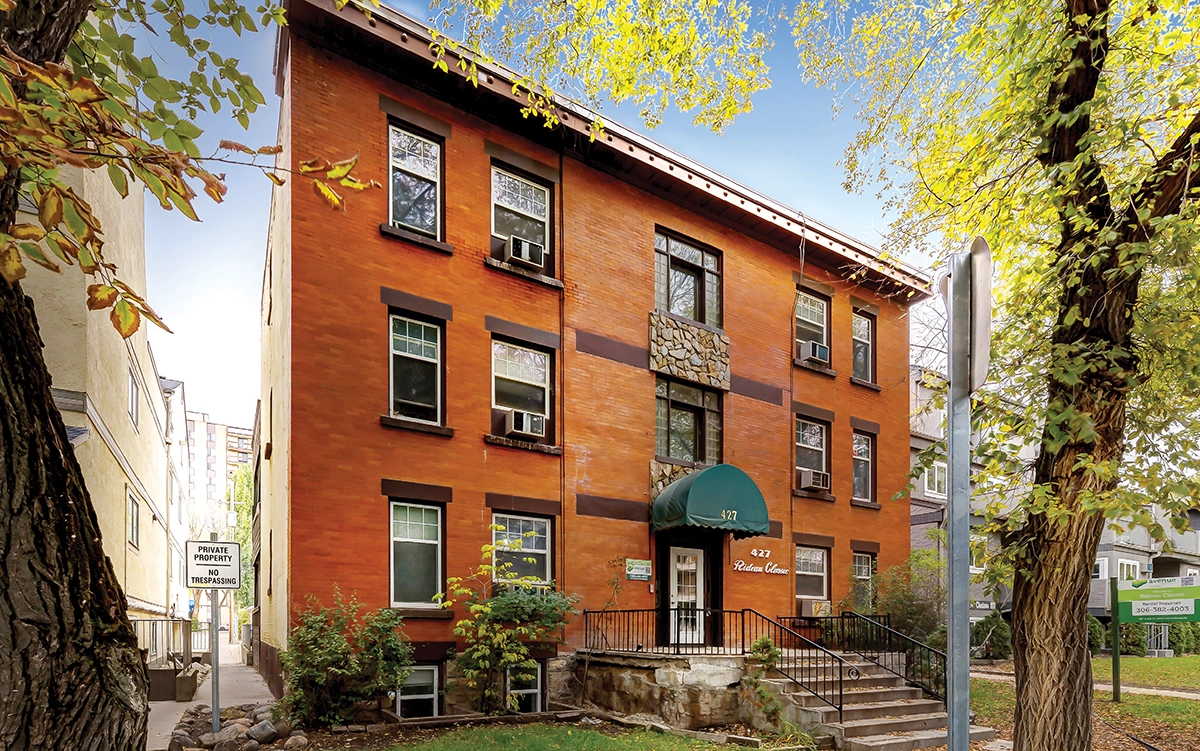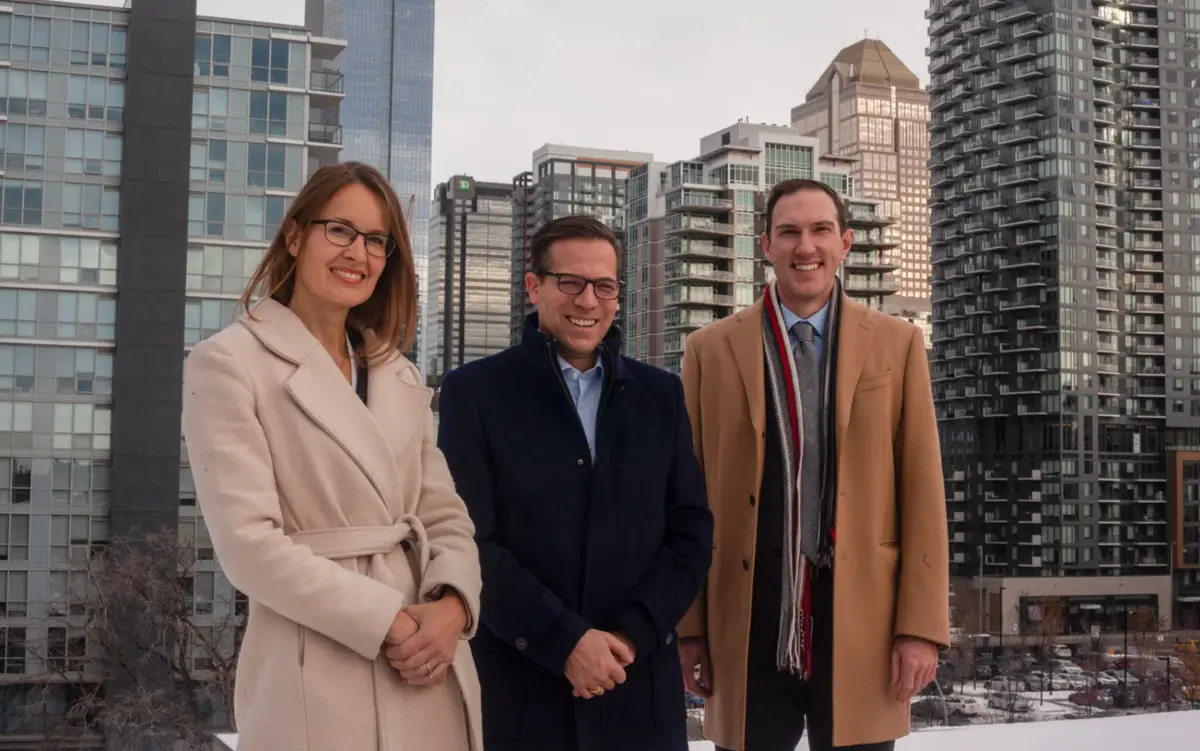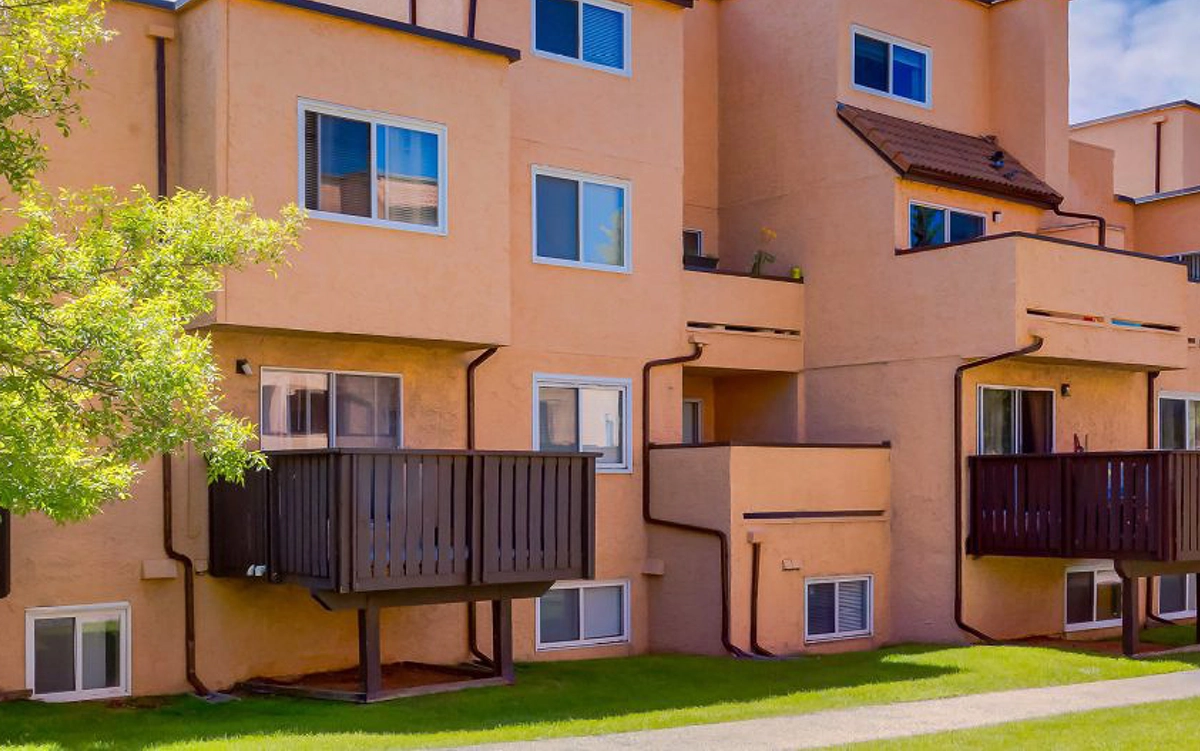The transformation of Edmonton’s The SunRise symbolizes a fresh start for the downtown community. Bringing life to 179 new homes in a centralized location supports an important demographic of Canadians including students, young professionals, and essential workers in their search for safe, comfortable housing.
Upgrades are aimed at reducing the carbon footprint of the building and showcasing the cultural heritage and vibrancy of the neighbourhood with a unique solar panel mural designed by local artist, Lance Cardinal.
The revitalized building is a key part of our broader commitment to sustainability across our portfolio.
The SunRise: Illuminating Edmonton’s Skyline with Renewal and Sustainability
When we began reconceptualizing Capital Tower in Edmonton, we knew it was only fitting the renewed building would need a new name. We’re pleased to unveil a fresh identity for the property, now called The SunRise. This renaming marks a significant milestone in the building’s history, symbolizing its extensive renovation and revival. The SunRise reflects a new beginning, promising a fresh outlook and enhanced living experience for the building’s residents. The property will offer modern amenities and a renewed sense of vibrancy to its inhabitants and the surrounding Chinatown neighbourhood — which is undergoing a revival of its own.
When selecting a name, we wanted to evoke a sense of optimism and positivity. Just as a SunRise marks the beginning of a new day, the name suggests a new beginning for residents who choose to make this apartment their home. Additionally, the imagery of a SunRise is often associated with warmth, light, and a welcoming atmosphere, all of which are qualities that many individuals seek in their living spaces. The name not only captures the essence of a new chapter but also conveys a sense of hope and inspiration, making it an appealing and meaningful choice for an apartment building.
This name gains even more significance with the addition of a one-of-a-kind solar panel mural to the building’s North exterior. This building is a fixture of Edmonton’s iconic Chinatown, and the location of the SunRise is within the Treaty 6 territory. As such, the mural depicts the unity, coexistence, and cultural parallels between First Nations and Chinese cultures, incorporating imagery from the Cree seven sacred grandfather teachings and the Chinese zodiac. This impressive feature enhances the properties’ aesthetics and underscores Avenue Living’s commitment to sustainability. The mural, which collects solar energy, serves as a display that reflects the neighbourhood’s unique heritage but also demonstrates the building’s focus on harnessing renewable resources, making “SunRise” an apt name for this innovative apartment complex.
To learn more about the project, check out our blog, ‘Capital Tower: A Beacon of Sustainability and Community Revival in Edmonton’ which outlines the building’s history and the outcomes of the renovation.
This commentary and the information contained herein are for educational and informational purposes only and do not constitute an offer to sell, or a solicitation of an offer to buy, any securities or related financial instruments. This article may contain forward-looking statements. Readers should refer to information contained on our website at https://avenuelivingam.wpenginepowered.com/forward-looking-statements for additional information regarding forward-looking statements and certain risks associated with them.
Stability, Growth, and Sustainability: Avenue Living’s Themes for 2023
2023 was a challenging year for Canadians and the broader markets. While inflation has slowed and interest rates appear to have stabilized, the overall economic picture continues to fluctuate.
“It’s been only one year, but we’ve seen changes that you don’t normally see within five,” says Gabriel Millard, Senior Vice President, Capital Markets – Equity and Research. “We’re still in the midst of digesting one of the fastest rate-hiking cycles in history, with a lot of variables in the macro environment.”
In light of this, investors have expressed increased interest in alternative investments for stability and returns that are non-correlated to public markets. Against that backdrop, we’ve continued to invest in the everyday, striking a balance between defensibility, growth, and sustainability across our strategies.
Multi-family and self-storage: from pause to growth
“During the first nine months of 2023, we took a deliberate pause on acquisitions within both our multi-family and self-storage strategies,” Millard says. “Over that time, we saw material net operating income (NOI) improvements from rent adjustments enabled by heightened service standards and introducing new operational cost-efficiency measures.”
Avenue Living shifted gears in the back half of the year, adding over 1,600 units to our multi-family residential footprint. In November, we finalized a deal with a large institutional investor for a 700-unit portfolio across five towers and a number of townhomes.

“We’re seeing opportunities to acquire higher-value properties from institutional players, including pension funds, which weren’t available even two years ago,” Millard says.
As borrowing costs accelerated, the importance of vertical integration, active property management, and managing rising costs in the real estate space became acutely clear. Across both the multi-family and self-storage markets, pure capital allocators struggled to sustain their investment returns, creating more acquisition opportunities.
“We’re exiting 2023 at just over 17,000 multi-family units,” Millard says. “The Mini Mall Storage Properties fund also grew quite rapidly to almost 8 million square feet — including the largest acquisition in its history of almost 900,000 square feet across 19 properties — making Mini Mall the top 21st largest self-storage operator in North America by rentable square footage.”

The multi-family Prairie markets are seeing growth from record net immigration, driven by households seeking affordability. A sizeable portion of these newcomers are coming from higher-growth markets like Vancouver, Toronto, and Montreal where rent payments can take up 40% to 50% of households’ income.
Historically, self-storage has proven to be a resilient asset class and remained stable even in times like the 2008 North American real estate crash. Robust consumer-driven demand continues to propel the investment class, painting a constructive picture.

Strong tailwinds for Canadian farming
Avenue Living’s two Saskatchewan-focused agricultural strategies, the Avenue Living Agricultural Trust and Tract Farmland Partners LP (Tract), have also managed well amid persistent demand for farmland investment from across Canada.
In its mid-2023 report on farmland values, Farm Credit Canada saw Saskatchewan lead the nation with an average gain of 11.4%. Most locations in the province, the report said, saw increases between 7% and 11%. On the ground, Tract identified acquisition targets from word-of-mouth referrals within the farming community, a testament to its reputation as a trusted partner.
“It’s a consolidation play that’s still just in its early stages. An estimated 98% of transactions within the province remain outside of investment funds, and we’re continuing to acquire assets,” Millard says. “By the time we close a deal, we’re already seeing impressive appreciation.”
ESG efforts coming to fruition
Roughly two years after striking its partnership with the Canada Infrastructure Bank (CIB), Avenue Living is moving forward on a number of energy retrofit projects across its multi-family residential portfolio, including work on large solar arrays, exterior renovations, and mechanical upgrades.
“A large portion of the acquisitions in our self-storage fund are within the Sun Belt region of the United States. Our portfolio is made up of assets that are wide, not high,” Millard says. “That offers an abundance of roofline where we’re able to implement solar projects.”
Avenue Living’s agricultural strategy also lends itself well to ESG, given Canada’s outsized role in producing staple grain products.
“The opportunity to help improve food security for Canadians and other nations is something we’re very proud to be a part of,” he says.
Avenue Living released its first full ESG report in 2023, with a second one set to come out this year. Beyond that, we’ve bolstered our commitment to responsible investing. In 2021, we became a signatory to the United Nations-supported Principles for Responsible Investment (PRI) and over the last year we furthered our commitment and became members of the Responsible Investment Association (RIA).
Avenue Living continued its annual Avenue Giving campaign, bringing together donations from residents and staff to support local food banks. We also launched an Employer-Supported Volunteerism program in the last quarter of 2023. In three months, employees volunteered for over 160 hours with 10 organizations including local food banks, Canadian Blood Services, veteran and seniors’ resource centres, community kitchens, and drop-in centres across the Prairies.
For 2024, a continued stewardship focus
From the beginning, Avenue Living’s growth has been inextricably tied to its commitment to the customer. Millard says that focus will continue in 2024, along with a focus on ensuring defensibility across the organization.
“Since 2020, it’s been a volatile period, and 2024 doesn’t appear to be any different,” he says. “As a responsible asset manager, we’re maintaining a leverage profile in the low 50%, and keeping over 10% of our NAV in liquidity to ensure defensibility.”
Last year, Avenue Living acquired over half a billion dollars in multi-family assets. With a large pipeline of acquisitions, it’s pressing its growth advantage in 2024, allowing improvement of margins by spreading fixed head-office costs over a larger number of units.
“We don’t grow for the sake of growth, but to improve our overall operations through accretive transactions,” Millard says. “Through technology and operational improvements, our focus is to continually level up our operations for the benefit of our residents, customers, and investors.”
This commentary and the information contained herein are for educational and informational purposes only and do not constitute an offer to sell, or a solicitation of an offer to buy, any securities or related financial instruments. This article may contain forward-looking statements. Readers should refer to information contained on our website at https://avenuelivingam.wpenginepowered.com/forward-looking-statements for additional information regarding forward-looking statements and certain risks associated with them.
Capital Tower: A Beacon of Sustainability and Community Revival in Edmonton
The Benefits of Submetering in Multi-Family Residential
Rising energy costs and the environmental impacts of energy consumption are at the forefront of Canadians’ minds. Statistics Canada reported that Alberta’s electricity prices rose by 128% year-over-year in July. These increased costs, along with the environmental impacts around energy consumption, have prompted organizations and individuals to look for ways to reduce their utility usage.
Traditional methods of charging residents for utilities by including them in fees (based on square footage, for example) might seem straightforward on the surface, but it can end up costing both property owners and residents more.
Residential and commercial buildings in Canada account for 17% of our energy consumption. Reducing that consumption is a key part of the overarching strategy to reduce our greenhouse gas emissions and help meet the Government of Canada’s commitment to achieve net-zero by 2050.
Different Methods of Utilities Distribution
There are three main ways to deliver utilities to a residential unit in a multi-family property.
- Master meters: Traditionally, utilities have been delivered to a master meter, and the total cost of these services is split evenly between the units and included in each resident’s monthly rent. Every resident pays the same price, regardless of how much water or electricity they use each month.
- Individual unit meters: Some properties use individual meters in each suite, and utility hookups and pricing are managed directly by the resident. They assume the costs of access fees and other riders connected to their utility bill and are subject to rate fluctuations. In this case, property owners have no visibility into what the resident is using or how much they pay.
- Submeters: Properties with submeters receive water, gas, and electricity through a master meter, but also have a submeter in each unit to measure individual consumption. Residents pay the submetering company for their utilities, based on how much they use. The property owner might assume the access fees and the resident may have the benefit of a lower rate if the property manager has negotiated one with utility providers.
The Benefits of Submetering
When it comes to energy consumption, knowledge is power. With submeters in each unit, both residents and property owners have a deeper understanding of consumption habits and opportunities to reduce waste.
A clear picture. Individual submetering allows residents to see how much energy they use, and property owners can understand their residents’ usage. With a clear picture of consumption, property owners can make informed decisions about equipment maintenance and upgrades, finding ways to optimize the building’s energy use overall. In turn, residents can see their own consumption patterns, and make decisions accordingly.
Responsibility… and accountability. With submeters, residents are responsible for their own energy, heat, and water use rather than paying a portion of the bill for the entire building. They only pay for what they use, rather than what their neighbours might be consuming. This motivates residents to be mindful of their daily energy usage.
The potential for better rates. Some property owners, like Avenue Living, can negotiate lower bulk utility rates for their residents rather than a single customer could on their own. In addition, property owners might assume some or all of the access fees.
Environmental benefits through reduced emissions. Studies suggest that submeters can reduce a building’s energy consumption significantly — a study in New York revealed that submetering reduced consumption by 18-25%, while a building in Ontario recorded even bigger savings (approximately 40%). This is likely because residents can see their consumption and make choices to reduce it, and property owners can realize the tangible benefits of installing energy-efficient fixtures.
Increased efficiency and building value. The ability to monitor consumption also helps property owners and managers spot equipment failures or building inefficiencies. A spike in water consumption could indicate a leak, for example, or high energy use could flag the need for appliance upgrades. This insight allows the property owner to be proactive about maintenance, increasing the property value and comfort for residents.
Avenue Living’s Submetering Strategy
Avenue Living has transitioned several buildings to a submetered system. The submeters we have installed are certified by Measurement Canada, and the program is implemented through a certified third-party provider.
“Avenue Living still covers the cost of utilities in common areas and vacant units,” notes Daniel Klemky, Energy Manager at Avenue Living. “But with submetering we can now give residents the tools to take control of their own costs and be accountable for them. In many cases, we also give people the benefit of a much lower utility rate, due to our negotiations with the providers as part of our procurement strategy.”
The comprehensive insight we get from submetering will allow us to accurately measure the impact of our energy efficiency capital improvements (e.g., replacing a furnace or installing solar panels). And as we continue to upgrade our properties through the deep energy retrofit program, in partnership with the Canada Infrastructure Bank, submetering will play a crucial role in meeting the reporting and data collection requirements.
Submetering provides numerous benefits to both the resident and the owner and is becoming a common tool for property managers to quickly take control of energy consumption, and reduce emissions and operational costs.
This commentary and the information contained herein are for educational and informational purposes only and do not constitute an offer to sell, or a solicitation of an offer to buy, any securities or related financial instruments. This article may contain forward-looking statements. Readers should refer to information contained on our website at https://avenuelivingam.wpenginepowered.com/forward-looking-statements for additional information regarding forward-looking statements and certain risks associated with them.
Revitalizing Canada’s Housing Landscape: The Crucial Role of Retrofits
As cities across North America deal with a growing crisis in affordable housing, it is clear that the solution is not one-size-fits-all and it involves more than simply building new stock. The Canada Mortgage and Housing Corporation (CMHC) estimates that Canada needs to add an additional 3.5 million units, above the current build pace, by 2030 to restore housing affordability. With rising interest rates and inflated costs, the ability to own a home is becoming out of reach for many. Further, there’s a concern that there are not enough rental properties for the population who need them. Add to that the constraints of building permits, labour shortages, and spiralling costs for developers, it is essential to look at other ways to support individuals and families. One such approach is to retrofit existing housing stock.
While building new homes is essential and necessary, reinvigorating existing housing is equally as important to ensure that people have safe and comfortable homes and to curb greenhouse gas emissions. With approximately 90% of Canada’s existing multi-family housing built before the year 2000, many of these buildings are reaching an age where renovations and upgrades are required to improve overall energy efficiency and quality.
In a recently published CMHC report, it states that in order to achieve housing affordability, there must be a “variety of housing options available” including those for both ownership and rental, a mix of single-family and multi-family homes, and new builds and retrofits. “Partnerships and innovation are needed in all parts of the housing system,” says the report.
Strategic Retrofits Are Key
In 2022, Avenue Living embarked on a landmark partnership with the Canada Infrastructure Bank and other key industry partners to retrofit approximately half of its multi-family portfolio. The initiative demonstrates a solid business case for the property management industry to make widespread changes.
Catalys, an energy and sustainability program designer, and one of the partners we have engaged to help achieve our deep retrofit goals, understands exactly what a difference these improvements can make. The firm has a track record of working with a variety of enterprise clients to help reduce their environmental impact by designing energy and sustainability programs, either through retrofits or improved processes. Catalys employs a data-driven technology and AI analysis model that helps property owners maximize the environmental benefits of retrofits and other investments.
“The environmental impacts of demolishing an existing building and replacing it with a new development can be significant,” says Luke Ferdinands, CEO of Catalys. “Both deconstruction and construction are waste-intensive, and a deep refurbishment of an existing building cuts operational carbon emissions — without the emissions associated with building new. Approximately 60% of embodied carbon emissions are associated with the sub-structure, frame, upper floors, and roof of a building. A deep retrofit will generally retain these elements, meaning on average, the carbon footprint of a refurbished building is about half that of the newly-built replacement.”
The firm has provided consultation and support to Avenue Living throughout the project, from feasibility studies to ongoing program management. As the retrofits scale, Ferdinands and his team will continue to assist with managing complexity, verifying performance, and measuring success through data tracking and analysis.
Benefits of Retrofits, from the Bottom (line) Up
Retrofitting can be completed much more efficiently than new builds, which often require lengthy schedules due to permitting and other considerations. “In Canada, a new building can take well over two years to be completed”, says Ferdinands. “Retrofits can take far less time — and they can benefit from streamlined processes that some municipalities have in place to expedite the permitting for such projects.
“When executed properly, deep retrofits can deliver buildings that appear to be totally different — they look newer and with a more modern aesthetic,” continues Ferdinands. “But more importantly, the resident experience of living there is also significantly improved.”
Studies show that living in an energy-efficient or “green” building improves residents’ overall quality of life. Not only are they living in more comfortable spaces, but they experience better health through upgraded lighting and balanced heating and cooling. In many cases, these buildings can become a vital part of the social fabric of a community — as Canada’s Green Building Council (CGBC) notes, “everyone benefits when community members have access to healthy, affordable housing and when communities are resilient and can withstand extreme weather events.”
Not all retrofits involve turning over the entire building; some upgrades can be quite simple, yet still achieve positive results. Less complex upgrades, such as boiler replacement or rooftop solar PV installations, mean residents can remain in place as retrofits occur with minimal disruption in their daily lives. “From a continuity perspective, it’s really important to make these upgrades as seamless as possible to minimize the impacts to the people who have made that building their home,” says Ferdinands.
These retrofits bring aging stock up to today’s standard, but they also ensure buildings are optimized for the future. “We’re making these buildings much more resilient,” says Ferdinands. “With more extreme weather — hotter summers, colder winters, and wildfire smoke – these upgrades really tighten up the building. We’re redoing roofs, adding insulation, improving windows, all of which help the building perform better in different conditions.”
Social Benefits
Ensuring existing buildings remain comfortable, desirable, and affordable places to live helps preserve communities. The ability to live in established neighbourhoods close to transit routes, schools, employment, and amenities offers a better quality of life for renters and encourages neighbourhoods to remain vibrant. Residents who are happy with their neighbourhood and comfortable in their homes are likely to stay, bringing added economic stability to a community. In addition, retrofitted, affordable rentals support a growing and stable population, and encourage local economic growth as working renters, seniors, and children all participate in their community, supporting nearby businesses and services.
“Renewing these older buildings is vital for communities,” says Gabriel Millard, SVP, Capital Markets – Equity & Research, who notes that many are often demolished and replaced with larger, more expensive rental properties. “In Canada, where we have fewer and fewer options at the less costly end of the rental spectrum, renewal helps extend the lifespan of these buildings so they can keep housing families. We’re making sure that important piece of the rental puzzle stays on the market.”
Retrofits for the Future
As we deal with two major challenges — housing affordability and environmental impact — it’s becoming clear that retrofits to existing buildings are a key part of the solution. Through a strategic and sustainable implementation, property managers can bring buildings up to date without losing occupancy. At the same time, residents can reap the health, social, and financial benefits of having a comfortable, affordable place to live in an established community.
This commentary and the information contained herein are for educational and informational purposes only and do not constitute an offer to sell, or a solicitation of an offer to buy, any securities or related financial instruments. This article may contain forward-looking statements. Readers should refer to information contained on our website at https://avenuelivingam.wpenginepowered.com/forward-looking-statements for additional information regarding forward-looking statements and certain risks associated with them.
Walking the Talk: How Avenue Living Brings Sustainable Investing to Life
As a major property owner and operator across North America, we have the unique opportunity to make a significant positive impact and set a great example within our industry. Avenue Living’s CPO, Max Graham, joins Wealth Professional to discuss how we’re focused on making ESG a strategic and repeatable piece of our business.
Read more about how we’ve integrated ESG principles into our daily operations.
REimagining Real Estate with Anthony Giuffre
Building a Culture of Safety at Avenue Living
A happy workplace is a productive workplace. But did you know that safety is a major contributor to employee satisfaction? Workplace injuries carry a significant impact, impacting tens of thousands of workers every year, affecting their families, co-workers, and communities. In 2022, Canada’s Worker’s Compensation Board (WCB) reported there were 4.33 injuries per 100 workers in Canada.
One of Avenue Living’s core values is “Duty of Care,” and while we often talk about it in relation to our residents, customers, and our investors, it also applies to our workforce. That duty manifests itself in creating an environment that seeks to minimize risks for every member of our team, whether they work in our offices or out in the field.
Safety is more than a set of policies and procedures, it’s part of an organization’s culture, and it flows from the top down.
“Safety is connected to everything,” says John Price, Senior Vice President Health, Safety, and Environment (HSE). “The better your safety culture, the more engaged your teams are. Studies show that organizations who have highly engaged employees can reduce safety-related incidents by up to 70 per cent.”
An article published by the Harvard School of Public Health notes that “engaged workers are more likely to be aware of their surroundings and best safety practices making them more likely to take steps to protect their co-workers.”
This engagement also has a ripple effect. “Everyone wants to feel that they’re valued,” says John. “It’s true that happy employees are the best employees. It’s a key ingredient in building the highest performing teams.”
In practical terms, facilitating safe work environments results in bottom-line benefits: reduced absenteeism, better employee retention, lower insurance costs (through reduced claims and a better safety record), and better overall performance. While there’s no way to eliminate risk completely, a positive safety culture increases trust throughout an organization — both with employees and their peers, and between employees and management, reducing disruptions to business.
Avenue Living’s Culture of Safety
“We’re focused on putting the tools for safety in people’s hands before they start work,” says John. Those tools include high-tech solutions but also plans and policies, training, and an organization-wide mindset that prioritizes everyone’s well-being. “Most workplace injuries are preventable when we’ve adequately equipped our teams with the knowledge, solutions, and planning necessary to carry out their jobs safely and effectively.”
We achieved our Safety Certificates of Recognition (COR) from the Alberta government starting in 2020, which requires third-party audits of safety practices, and we’ve implemented various technological tools to help keep our remote workers safe, track incidents, and monitor hazards. Software such as SitePhotos allows us to share visual records of maintenance jobs, and the ClearRisk application helps us track hazards and document risk mitigation. For lone workers, SolusGuard provides an extra layer of security via a panic button and app that prompts regular check-ins.
Always Moving Forward
But technology is only part of the story. A culture of safety ensures that everyone in the organization, from the top down, is committed to preventing incidents and putting barriers in place so when an incident occurs, no one gets hurt. Humans make errors and it’s important that, as a company, we work together to build capacity around these situations. “It’s how we grow and improve. There’s no better teacher of how to make work safer than those who perform the tasks,” says John.
Continuous improvement is a cornerstone of our organization, and we’ve taken a closer look at how our HSE team is structured and found a way to best serve the diverse needs of our different business units.
“We’re creating some bench strength and giving each team dedicated specialists,” says John, who notes that the restructuring was in response to hearing different business units’ needs. Now our self-storage, property management, and other areas have their own single point of contact with the safety team. This structure allows our safety specialists to develop deep knowledge of each business and work closely with the team to identify challenges and create solutions. This is key to a proactive safety culture.
Over the past year, we have also developed more robust emergency plans. For example, in March 2023, we launched an emergency response plan across the organization that outlines safety procedures for potential risks.
Across our organization, we’re developing a robust incident command system to help our teams manage emergencies such as extreme weather events. This system provides a platform for how we respond and recover from major events that affect our customers, teams, and assets.
Additionally, management performs regular site visits. “Being on-site is the best way for them to understand the safety requirements in our day-to-day operations,” says John. It also allows opportunities for the entire team to connect in person, strengthening trust and opening the lines of communication.
All these efforts serve to keep us — and the communities in which we work — safe. And they have an added benefit. As a customer-centric organization, taking care of each other allows us to focus on the thing that sets us apart: delivering superior service to our residents and customers across North America.
This commentary and the information contained herein are for educational and informational purposes only and do not constitute an offer to sell, or a solicitation of an offer to buy, any securities or related financial instruments. This article may contain forward-looking statements. Readers should refer to information contained on our website at https://avenuelivingam.wpenginepowered.com/forward-looking-statements for additional information regarding forward-looking statements and certain risks associated with them.
How a Resident-Centred Approach Has Differentiated Avenue Living
A resident-centred approach is foundational to our property management philosophy and a key differentiator of our business model. Putting our residents’ needs at the heart of our acquisition, expansion, and service strategy has been key to our ongoing success.
Read more about how embracing vertical integration has allowed us to create a sophisticated, innovative property management platform.
Multi-Family Retrofits: The Case for Going Green
In June 2022, Avenue Living and the Canada Infrastructure Bank (CIB) joined forces to commit $162 million towards deep retrofits across our Canadian portfolio. The partnership will fund upgrades to 220 residential buildings, touching approximately 6,700 homes and helping lower the carbon emissions for nearly half of our Canadian portfolio.
As a key pillar of our ESG efforts and overall strategy, Avenue Living has always made responsible and impactful capital improvements — for example, installing a better-insulated roof, higher-efficiency windows, or a new boiler. These energy conservation measures (ECMs) extend the life of the asset and make living spaces more comfortable in summer and winter.
Our portfolio spans a region with some of the coldest weather in North America, and these upgrades help increase energy efficiency. A better-insulated building envelope, for example, keeps the building temperature more even year-round and allows heating and cooling systems to work more effectively. Upgraded high-efficiency HVAC systems, paired with better-insulated building envelopes, help reduce consumption.
In 2020, commercial and residential buildings accounted for 17 per cent of Canada’s GHG emissions (excluding construction and building materials, which pushes the number to 30 per cent). The Government of Canada is committed to reducing carbon emissions to below 45% of 2005 levels by 2030 and reaching net-zero by 2050 — and estimates that, to meet that goal, Canada needs to retrofit 600,000 homes and 750 million square feet of commercial space per year between now and 2040 to meet those commitments.
Avenue Living is doing our part while paving the way to setting a new standard in the multi-family industry. As an open-source advisor and collaborator, we are sharing how these retrofits can benefit investors, residents, and our communities at large. Our partnership with the CIB aims to reduce emissions from buildings in the program by 50 per cent, and pilot projects are already underway.
CHOOSING ENERGY CONSERVATION MEASURES (ECMS)
Retrofitting buildings to create the most energy savings is based on careful analysis, energy audits, and a well-developed strategy for capital improvements. As part of our current acquisition strategy, Avenue Living systematically determines which capital improvements will be the most impactful for each property. Deep energy retrofits are no different.
Before a property can be included in the CIB retrofit program, it must meet Investor Ready Energy Efficiency (IREE) Certification. IREE is a global framework that signals a building has undergone appropriate due diligence and the retrofit projects have been developed by qualified professionals who adhere to a series of protocols for assessing risk, comparing savings, and evaluating opportunities. This third-party certification reduces costs for transactions, capital, and due diligence and increases investor confidence through reliable and consistent projections.
Baselining is essential to determining the viability of any retrofit project, and as part of IREE protocols, our buildings have undergone multiple energy audits. When we examined our portfolio in search of the most impactful ECMs, we discovered our larger properties — those with more than 24 units — presented our best opportunity to reduce GHG emissions. Energy audits have also revealed that wood-frame buildings can be further optimized compared to brick or concrete buildings, which are already quite efficient. In addition, we closely evaluated other aspects of the building’s mechanical operations and construction for ways to increase efficiency — roofs, boilers, and exterior cladding, for example.
“As we were going through the program details, we looked at a number of factors to determine if a building would be a good candidate for upgrades, for example, will the improvements offset enough energy and emissions to be financially viable, or is the building equipment old or inefficient,” says Daniel Klemky, energy manager at Avenue Living. “If building equipment is reaching the end of its useful life, there may be an opportunity for us to modernize that property in a cost-effective way.”
Our retrofits include:
- Upgraded heating, ventilation and cooling (HVAC) systems, which allow us to heat and cool buildings more efficiently and keep temperatures even throughout the property
- An upgraded building envelope and roof, which improves insulation, eliminates the possibility of pipes freezing and improves aesthetics
- Triple-glazed, high-efficiency windows, to reduce heat loss (or gain)
- Low-flow water fixtures, to reduce water consumption and provide a better experience for residents
- LED lighting and more efficient fixtures, for brighter, more effective lighting in common areas
- Solar panels, where applicable, allow properties to generate their own power, reduce consumption, and offset operational costs
Implementing these retrofits requires coordination — and manpower. Our plan has incorporated a phased approach, which allows us to make as many updates as possible without overwhelming the trades in each city. This perfectly illustrates the combined benefit of environmental projects: job creation, and the need for expansion in the sector. Canada’s Green Building Council estimates that by 2030 the opportunities for growth in the green building sector could account for approximately 1.5 million jobs and contribute $150 billion in GDP.
“It is difficult to retrofit multiple buildings in a single market at one time,” says Ward Woolgar, senior vice president, capital investment at Avenue Living. “We’ve planned out our retrofits with projected schedules and dates to make sure we have the tradespeople we need available at each phase to minimize delays.”
The solar project slated for Wetaskiwin Mall, for example, requires extensive work on the roof. “It’s not as simple as just putting solar panels on top of the existing structure,” says Klemky. “There’s a great deal of work that has to happen to the roof first, such as detailed design, structural reinforcement, electrical capacity considerations, and regulatory restrictions.” The mall’s solar retrofit, however, will also account for the biggest reduction in emissions.
BENEFITS BEYOND EMISSIONS REDUCTION
While reducing consumption and emissions is our primary goal, we know that these building improvements have other benefits for residents. As an active property manager, we recognize that happy residents stay in their homes for longer, and these upgrades will enhance the comfort and livability of their rentals. Studies show North Americans spend approximately 90 per cent of their time indoors, so air quality, temperature, and lighting are more important than ever.
These renovations require minimal disruption to residents’ lives or schedules, and in most cases happen outside the suites. Although retrofits like window replacement or upgrading water fixtures do require apartment entry, these jobs can be completed in just a few hours, like any regular maintenance task. That said, any construction work in a building has an impact on its occupants, and we’ve developed a plan to communicate with our residents early and often to ensure they understand the work schedule.
“These updates will have a noticeable effect,” says Woolgar. “For example, our upgrades to HVAC systems will mean there’s more even heating throughout the building, so we’ll avoid the problem with overheated hallways and common areas that a lot of apartment buildings have. New windows and fixtures will also mean residents can enjoy more even temperatures in their suites, better water flow and lighting, and improved aesthetics.”
A GREENER FUTURE FOR MULTI-FAMILY
The United Nations estimates that 80% of the buildings in cities today will exist in 2050. Reducing emissions through deep-energy retrofits is key to ensuring Canada — and the world — meets sustainability targets. For Avenue Living, the benefits of this retrofit project are very close to home: we see these retrofits as an opportunity to demonstrate to the industry what is possible. We aim to create a portfolio of properties that provide residents with safe, affordable, comfortable, and modern homes — ones that are well-equipped for a low-carbon future.
This commentary and the information contained herein are for educational and informational purposes only and do not constitute an offer to sell, or a solicitation of an offer to buy, any securities or related financial instruments. This article may contain forward-looking statements. Readers should refer to information contained on our website at https://avenuelivingam.wpenginepowered.com/forward-looking-statements for additional information regarding forward-looking statements and certain risks associated with them.
We’re Focussing on Housing Affordability for Essential Workers: Avenue Living CEO
Building our strategic, stable, and defensible business requires extensive research and planning, as well as a clear understanding of our target demographic — workforce housing.
Avenue Living CEO, Anthony Giuffre, joined Jacqueline Hansen of The Close to discuss the 16 years of experience behind the organization’s growth from an Alberta-based business to a significant property owner-operator across the North American Heartland. He addresses affordability, their asset and market selection process, and the demand outlook.
This commentary and the information contained herein are for educational and informational purposes only and do not constitute an offer to sell, or a solicitation of an offer to buy any securities or related financial instruments. This article may contain forward-looking statements. Readers should refer to information contained on our website at www.alamstg.wpenginepowered.com for additional information regarding forward-looking statements and certain risks associated with them.
Breathing New Life into Canada’s Housing Supply
Amid a growing wave of responsible investing, strategic partnership between Avenue Living and CIB paves the way for a greener, more sustainable future for investors and residents.
As a responsible private real estate investment manager, Avenue Living has long placed ESG at the forefront of its decisions and operations. With its focus on operating and maintaining workforce housing, as well as oversight through its flagship investment vehicle, the Avenue Living Real Estate Core Trust, the organization is no stranger to the social and governance piece of the puzzle. But several years ago, the firm saw an opportunity to go farther in its commitment to responsible stewardship. Read more about the pioneering partnership.
This commentary and the information contained herein are for educational and informational purposes only and do not constitute an offer to sell, or a solicitation of an offer to buy any securities or related financial instruments. This article may contain forward-looking statements. Readers should refer to information contained on our website at www.alamstg.wpenginepowered.com for additional information regarding forward-looking statements and certain risks associated with them.
Inside Innovation: Private REIT Taps the CIB for Multi-Unit Energy Retrofit Financing
The call has gone out from all levels of government for more affordable homes across Canada. However, solutions to the country’s housing needs must simultaneously address carbons and GHGs.
Rather than simply building new or tearing down and rebuilding some resolution can also be found by taking another look at existing buildings, particularly low and mid-density multi-family structures. Through major financing offered by Crown Corporation, the Canada Investment Bank (CIB), a privately-held Canadian REIT is tackling both the housing and emission issues head-on. Learn how Avenue Living is helping address the housing shortage, sustainably.
Avenue Living Receives CIB Funds for $150M in Sustainable Building Retrofits
CIB Commits $120 Million to Avenue Living
Calgary, AB, June 20, 2022 (GLOBE NEWSWIRE) — The Canada Infrastructure Bank (CIB) and Avenue Living Asset Management (Avenue Living) have entered into an agreement whereby the CIB and Avenue Living together will commit $150 million towards sustainable retrofit projects in low-density residential buildings across Western Canada.
Under the agreement, the CIB’s investment will represent 80 per cent of the overall capital value of the work. The timing of this investment coincides with Avenue Living’s corporate commitment to reduce greenhouse gas emissions while collectively addressing the prairie’s aging housing supply. The funds will improve the living conditions for thousands of Canadians.
Avenue Living’s multi-family residential business serves a significant segment of Canada’s lower- and middle-income workforce, known as the workforce housing rental segment. Specializing in Canada’s existing rental base, the company owns and operates more than 500 medium-density buildings, consisting of over 14,400 apartments and townhomes, in 20+ regions across Canada’s prairie provinces and the United States.
The goals of the sustainable retrofit projects include optimizing building performance, decreasing GHG emissions by more than 49 per cent, and enhancing functionality and comfort for occupants.
Projects will be delivered simultaneously and focus on renewable energy generation on-site, low carbon heating and cooling, sensors and smart thermostats, optimized air filtration, water and vapour management, and energy consumption strategies to effectively reduce in-suite utility costs for lower-income renters.
The CIB’s investment is aligned with Avenue Living’s demonstrated focus on responsible fiscal management, strong risk mitigation, and ingenuity through engineering, construction, and unique retrofit solutions.
The investment is expected to reach financial close in late 2022 with projects commencing shortly thereafter.
Endorsements:
“The CIB is an impact investor helping to develop the next generation of infrastructure which benefits Canadians. We are pleased to commit $120 million to Avenue Living and finance the modernization of aging assets. Our financing solutions assist residential real estate owners in the implementation of new retrofit projects to reduce energy use and GHG emissions.”
Ehren Cory, CEO, Canada Infrastructure Bank
“With over 90 per cent of Canada’s rental universe built before 2000, Avenue Living is excited to be a pioneer in retrofitting these older units. We are eager to set a new standard and enhance green infrastructure programs for the entire industry – for years to come. The work that we are doing with CIB represents nearly 50 per cent of Avenue Living’s overall portfolio. By 2027, we
have the vision of completing 100 per cent of our growing Canadian portfolio, continuing to positively impact the communities we serve.”
Anthony Giuffre, CEO, Avenue Living Group
Quick Facts:
To date, the CIB has committed $800 million toward energy retrofits.
The CIB’s Commercial Building Retrofit Initiative targets building retrofit projects with a minimum of 30 per cent greenhouse gas (GHG) emission reduction at the building level.
The CIB seeks to invest up to $5 billion into green infrastructure which supports climate change action and sustainable economic growth.
All CIB investments are subject to approval by its Board of Directors.
About Avenue Living Asset Management
Founded on the principle of investing in the everyday, Avenue Living focuses on opportunities that are often overlooked by others, having grown to over $3.7 billion in aggregate assets under management across four private real estate investment mandates. The Avenue Living team includes over 750 professionals with expertise in real estate operations and transactions, property management, research, investment origination, and capital markets, as well as a suite of subject matter experts to support Avenue Living’s growing portfolio of multi-family residential, commercial, agricultural land, and self-storage assets. In addition to over 14,400 multi-family units located in Canada and the United States, Avenue Living and its related entities own over 496,500 square feet of commercial space, 82,827 acres of productive farmland, and more than 3 million square feet of self-storage space.
Learn More:
Avenue Living Asset Management
This commentary and the information contained herein are for educational and informational purposes only and do not constitute an offer to sell, or a solicitation of an offer to buy, any securities or related financial instruments. This article may contain forward-looking statements. Readers should refer to information contained on our website at www.alamstg.wpenginepowered.com for additional information regarding forward-looking statements and certain risks associated with them.
Avenue Living Communities and Zenbase Partner to Offer Flexible Payment Options
Calgary, AB, June 16, 2022 (GLOBE NEWSWIRE) – Avenue Living Communities Ltd. (“ALC”) an owner-operator of over 14,000 apartments and townhomes across Alberta, Saskatchewan, and Manitoba, today announced a partnership with Zenbase, a leader in flexible split rent payments. This service, which allows residents to pay their rent on a schedule that better suits their income cycle, can offer some relief at a time when inflation is pushing household budgets to their limits.
“We’re always looking for ways to address what’s most important to our residents,” says Anthony Giuffre, Founder and CEO of Avenue Living Group. “We know how important the social aspect of our Environmental, Social, and Corporate Governance commitments are, and we’re continuing to support our residents with compassionate options to help address their day-to-day challenges.”
Koray Can Oztekin, CEO and Founder of Zenbase agrees. “Our company partners with like-minded property management organizations who want to improve the financial health of their residents while at the same time increase on-time rent collections and eliminate operational overhead. ALC has fully leveraged the benefit of our solution, delivering financial relief and flexibility to thousands of Canadian renters.”
As inflation and interest rates both rise, Canadians are being challenged with various costs, such as food, gas, and rent. Amidst these struggles, Canadians are actively seeking financial flexibility from different service providers. Single-payment plans, locked-in schedules, and late fees continue to be a significant stressor for many renters. Zenbase offers an automated solution that aims to put an end to the key challenges around rent payment. The company’s core financial product enables flexible rent payments, allowing residents to split their monthly rent into smaller installments within a month.
Zenbase has benefits for property owners, as well, helping ensure guaranteed rent payments and reducing the time spent on rent collection. This partnership with ALC, the fastest-growing multi-family housing owner-operator in Western Canada, has the potential to reduce late rent payments by over 27 per cent while driving a positive resident experience and supporting them during difficult times.
“Zenbase is a fantastic technology solution that allows us to be more efficient on the back-end while at the same time, empowering our residents to be in control of their financial situation,” says Giuffre. “Zenbase has become an integral part of our operations and the platform delivers on our commitment to create a superior customer experience for our residents — one that provides flexible options and peace of mind.”
About Avenue Living
Founded on the principle of investing in the everyday, Avenue Living focuses on opportunities that are often overlooked by others, having grown to over $3.7 billion in aggregate assets under management across four private real estate investment mandates. The Avenue Living team includes over 750 professionals with expertise in real estate operations, property management, and asset management to support Avenue Living’s growing portfolio. In addition to over 14,400 multi-family units located in Canada and the United States, Avenue Living and its related entities own over 496,500 square feet of commercial space, 82,827 acres of productive farmland, and more than three (3) million square feet of self-storage space. Learn more: alamstg.wpenginepowered.com/
About Zenbase
Zenbase, a leader in flexible rent payments, is committed to economic inclusion that fosters financial empowerment for renters. Zenbase’s solutions improve the financial wellness of renters while improving operational efficiency for property managers. Rent is usually due on the first of the month but that doesn’t align with most people’s bi-monthly pay cycle. Zenbase addresses that misalignment and provides other financial tools to help level the playing field. Learn more: https://myzenbase.com/
This commentary and the information contained herein are for educational and informational purposes only and do not constitute an offer to sell, or a solicitation of an offer to buy, any securities or related financial instruments. This article may contain forward-looking statements. Readers should refer to information contained on our website at www.alamstg.wpenginepowered.com for additional information regarding forward-looking statements and certain risks associated with them.
